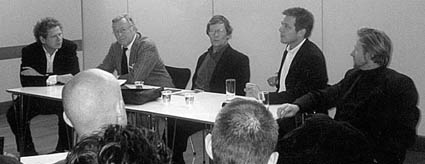Dogme 95: The Vow of Chastity (abridged):
I swear to the following set of rules drawn up and confirmed by Dogme 95:
- Shooting must be done on location. Props and sets must not be brought in.
- The sound must never be produced apart from the image or vice-versa.
- The camera must be handheld. Any movement or mobility attainable in the hand is permitted.
- The film must be in colour. Special lighting is not acceptable.
- Optical work and filters are forbidden.
- The film must not contain superficial action.
- Temporal and geographical alienation are forbidden.
- Genre movies are not acceptable.
- The film format must be Academy 35mm.
- The director must not be credited.
Furthermore I swear as a director to refrain from personal taste. I am no longer an artist. I swear to refrain from creating a 'work', as I regard the instant as more important than the whole. My supreme goal is to force the truth out of my characters and settings. I swear to do so by all the means available and at the cost of any good taste and any aesthetic considerations.
In 1995 a collective of Danish directors, including Lars von Trier and Thomas Vinterberg, established the manifesto above to govern the manner in which their films were to be shot. Dogme 95 - The Vow of Chastity has already resulted in two interesting films. Both were shown at the London Film Festival 1998, von Trier's Idiots and Vinterberg's Festen.
The Dogme film No. 1 is Vinterberg's Festen. Before the title sequence the Dogme manifesto certificate is showed with the number of the film. Central to the plot is the 60th birthday party of Helge, the father of four children. The eldest son Christian reveals the dark secrets of his childhood to the assembled guests. With natural lighting, sound and hand-held video camera Festen creates disorientating images as disturbing as the content of the story. As the film is shot with a digital video camera and blown up to 35 mm, the material is very grainy on the big screen of a cinema theatre (on Video this graininess is invisible). The aesthetic of the movie resembles the aesthetic of the French New Wave, as hand-held camera equipment was used extensively. Vinterberg sees the vow of chastity as liberation from technical considerations and the limitations as inspiration. But also the collective aspect appeals to him. Festen was awarded with the Jury Prize in Cannes this year.
The second film of the Dogme group is Idiots by Lars von Trier, who is already famous for Breaking the Waves(1996). A group of young people, who live in a large house, pretend in the public to be idiots. They try to find their 'inner idiot'. By accident Karen gets involved in this group. In the end it turns out that one of them really had the disease the others were pretending and the group falls apart. Some serious questions about society's attitude to the disabled arise when watching the movie. The funny thing is the reactions to the idiots rather than the idiots themselves. The film is very provocative because of its sensitive subject. The movie seems to break with the Dogme rules, as film music appears, but von Trier reveals in an interview that the source of the music - the harmonica player - was located behind the camera while shooting. So the sound is always recorded with the image, however tricky this is to achieve.
Filmmakers have often used the limitations placed upon them as inspiration, but few have used formulated restraints on their own freedom. However strictly the filmmakers really follow their own rules, the existence of Dogme 95 led to increased public interest in Danish cinema and provoked debate. The motivation behind the vow of chastity could be something between a gimmick and a serious attempt to produce a pure form of cinema but it had it's first impacts: the Danish government has offered increased financial support. State film funding will increase by 70 % over the next four years.
London
15.1.1999


